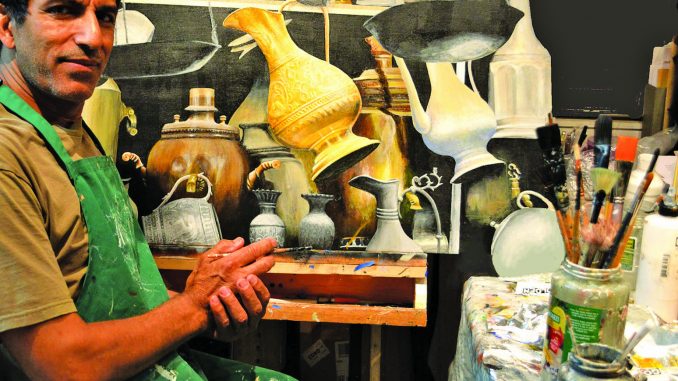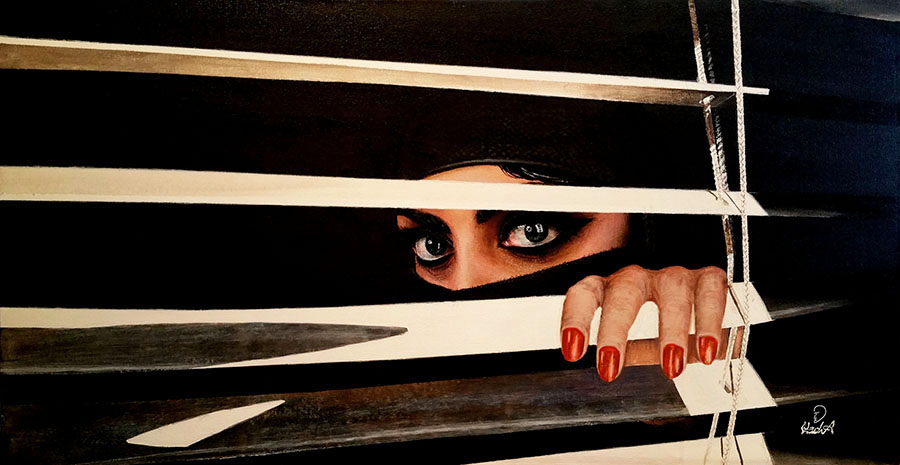
BY RYAN MCCROSSIN
Daily Post Staff Writer
Hadi Aghaee isn’t afraid of offending anyone when he exhibits his art, some of which is fiercely critical of cultures around the world, this weekend in Palo Alto as part of Silicon Valley Open Studios.
The Iranian Revolution in 1979 and the turmoil it caused in his life led to him bottling up his talent inside for three decades. Now his feelings and art, sealed up and shaken inside of him for so long, are pouring out of his mind in an explosive stream and he is thrilled.
“I notice people appreciate it if you are trying to say something and I think I found my calling … even though I know these kinds of things won’t sell,” said Aghaee, who will show his painfully realistic paintings from 11 a.m. to 5 p.m. tomorrow (May 5) and Sunday (May 6) at 2510 Greer Road.
Painter LaRhee Webster is hosting him along with artists Marika Anderson and Linda Maki. Hundreds of other Peninsula artists will be showing their work at homes and galleries for free this weekend and the next two weekends.
Aghaee, 62, didn’t receive any formal training in art as a youth in Shiraz, Iran, but he lived among majestic buildings that are architectural and artistic wonders.
One of his favorite “playgrounds” as a child was Vakil Mosque, which is hundreds of years old. He remembers scribbling his foot tracks on the floor as he weaved between the many spiraled stone columns that form regal archways inside. Perhaps when he tired he gazed up and marveled at the blue and yellow geometric designs painted on the tiled ceiling.
Introduction to America
When he got a little older he drew his family, friends and scenery, but his work didn’t contain social commentary.
At that time there was stability in Iran and Aghaee met many U.S. tourists at his late father’s metal shop. They were awed by the metal smith’s “art,” tools that he shaped out of melted tire shocks. They prized his files, which were used to sharpen knives, because he etched intricate patterns on them.
“That’s what interested me to come to the U.S. because Americans come and they are interested in what my dad does and they take pictures,” Aghaee said. “So I went and took a few English classes in Iran. I was able to tell them what the prices is or ‘hi’ or ‘bye.’”
Perhaps he started to realize the power of art to spark conversation and bridge cultures. But Aghaee immigrated to America in 1976 and studied civil engineering at Southern Illinois University to please his parents. Three years later, his life was turned upside down.
Start of turmoil
Rebels overthrew Iran’s U.S.-backed government in a bloody war and Americans were held hostage at the U.S. Embassy for more than a year. Then came the Iran-Iraq War in which hundreds of thousands were killed, including some of Aghaee’s family.
He was lucky for having left Iran but life wasn’t easy in America. Iran didn’t allow money to leave the country so his parents cut off his tuition funds. He faced deportation if he didn’t stay in school so he worked three jobs while studying full time. There was no time for art.

Furthermore, he was struck by a harsh backlash due to the hostage crisis. People may not have been receptive to his art.
“You walk in the street, somebody hit you with an apple or corn stalk or somebody opens their window, some say something nasty to you,” Aghaee said. “At that time, students got beaten up by people thinking they are Iranian but they happened to be Italian.”
He said much worse happened but it’s too painful for him to discuss.
Rather than release his stress through art, his gift stayed inside him pressurizing, fermenting. He graduated in 1982 and darted toward the Bay Area for its Persian community but he ran out of gas in Arizona.
Aghaee couldn’t get a civil engineer job in Arizona and places like McDonald’s rejected him because he was overqualified. He was forced to live in his car for awhile. Aghaee eventually found jobs such as digging trenches or working as a hotel cook. That life filed on him, though, until his resolve finally sharpened.
He returned to school to study electronics and he moved to the South Bay in 1988 after getting a job in the semiconductor industry.
There was still no time for drawing while working up to 11 hours a day and starting a family.
He didn’t even think about art unless someone else brought it up. At those times his talent started to stir and bubble inside him. He wondered what he might have accomplished. What if he uncorked it? Had regret, bitterness and neglect spoiled it or would it flow easily and sweetly from him?
Return to Iran
A 2014 trip to Iran loosened the seal on his art. His homeland didn’t match his mental painting. Part of his childhood “playground” had been destroyed by war or replaced. He learned two of his younger brothers died in the Iran-Iraq War. The faces of the people he once drew had become more stern.
“Everybody was in war, nobody was making money and whoever was left was for himself, trying to survive,” Aghaee said. “(War) changed the attitude of people a lot.”
But he was touched that his family still savored his old art, which covered the walls of their homes. They encouraged him to do more. Then when he returned to San Jose, a neighbor pried open his talent for good.
“She saw a couple of old works from the 70s which I have and she said … ‘Why don’t you come to my studio sometime, draw something?’” Aghaee said. “She insisted a lot and one day I went.”
She pushed the sketcher to try painting. He created a beach with a serene ocean and a bright blue sky. One of three sailboats in the water bears an Iranian flag. It could represent him at peace in the U.S. as well as the start of a new journey.
“She said, ‘Hadi, you’re a natural. You should do more.’ She started encouraging me,” Aghaee said. “So that’s how it started.”
One of his first missions as a full-time artist was to preserve his Iranian memories. He turned photos he took of treasured places, including Vakil Mosque, and people enjoying nature into paintings.
Some are created with hundreds of dots in a technique called pointillism and they’re fuzzy like fading memories. Others are so realistic they transport the viewer to Iran. These pieces helped him sharpen his artistic tools before he melted down his old style and shaped something new.
“After doing all my practices with all styles of different things I have found my way,” he said. “I want my painting to say something and I want people who see it to also hear it.”
Much of his latest art is not as pretty as his earlier work but it is likely to grab hold of viewers. In one painting, which looms over his desk, a woman with wide blue eyes that seem to swell with fear and longing peeks through window blinds. One can tell she is Muslim because she is wearing a hijab.
“It was early 2016 when there was a lot of Islamophobia especially in France and Europe,” he said. “People like her … they have to look, see if it’s safe to go out.”
It is called “Coerced Agoraphobia.”
Nobody would ever guess that the woman, with her beautiful eyes and soft features, was born from one of Aghaee’s selfies though it is appropriate. There were likely times in the 1980s when he was reluctant to go outside. The woman could also symbolize his long-captive artistic desire.
Confronting difficult issues
But there doesn’t seem to be much apprehension left in Aghaee, who in other paintings lifts up blinds and shines light on the darkest corners of society.
One powerful collage shows the abysmal treatment of women in Africa. A woman’s shadow looms behind a baby, symbolizing those who die in labor because of unsanitary child birth. A hand wields a razor blade in front of a crying girl to call attention to the problem of female circumcision. It also confronts rape and spousal abuse.
Aghaee stayed away from Iran for many years to avoid the draft but he confronts war head-on in one surreal painting. U.S. jets, the fronts of which are doves carrying olive branches, soar over a desert.
He said the planes represent how America enters the Mideast with one message but has other intentions. Bullet-riddled hands reach out of the sand, symbolizing the enemies that sprout up after the U.S. wages war.
“The mentality is you kill your enemy, everything will be solved,” he said. “But when you kill one you create yourself more enemies and it never ends.”
Aghaee doesn’t let the Mideast off his hook though. He scolds parts of the Muslim world for the ways it oppresses women. In the center of one collage is a muscular man, his entire body flexing as he pulls on ropes, straining to control every aspect of women’s lives. This painting and the African one are part of a global series about the mistreatment of women.
“They are very powerful as far as I’m concerned and I hope I will be able to do more because somebody has to say something,” Aghaee said.
Chances are he will do more. His paintings have already garnered awards and entered various museums. Even the woman with the large blue eyes has ventured outside his home to Stockton’s Haggin Museum, where she will stare down viewers.
For more information about Open Studios visit svos.org.

I think the U.S. has enough native anti-American “artists”, no need to import them from Iran. I can see why he would be well-received in the Bay Area though, it’s probably the least American part of the country. Why did it take him almost 40 years to learn his brothers had been killed in the Iran-Iraq War? It doesn’t seem like family is important to him. Given the snippets of his biography he sounds like a troubled person who could never get his act together. Maybe because Syrian refugees haven’t made it all the way to California, this is the next best thing to promote?
I know Aghaee a little and you may have made a few quick and erroneous conclusions about him. Honestly I’m pretty sure he wanted the article to be about his art- not him- so there is a reason you may have questions about him from a lack of details in the piece. I don’t see him as “anti-American” at all or particularly troubled- he just paints what he sees and what is important to him. If you are referring to an American fighter jet in his piece, that doesn’t trouble me at all as I know my history: America (particularly the CIA) had it’s hands in Iranian politics long before the 70s. As far back as at least the the 1953 CIA backed and financed coup of Mossadeq to install the Shah into power.
But again, I would hope people look at his art through more than a political lens as his subjects are personal and global at the same time (from what I have seen).
Thank you Patrick. I though my life story was for interviewer’s own to understand my art and not to be published in details. The commenter’s labeling of me as an anti-American is hurtful. And the part about me learning the fate of my brothers was from a trip in early 90’s not 2014. I did not have the opportunity to see the draft of the article before publication to correct such discrepancies. I personally am satisfied with the article none the less.